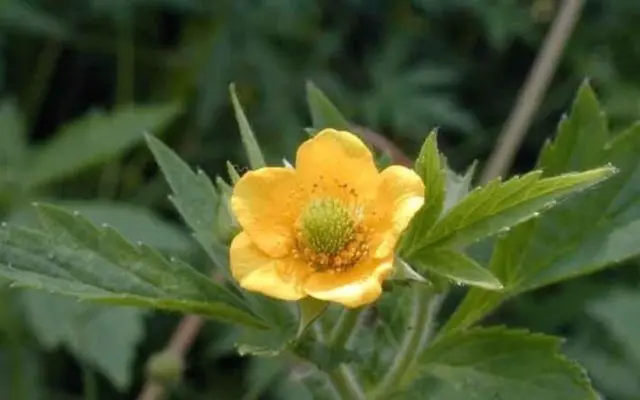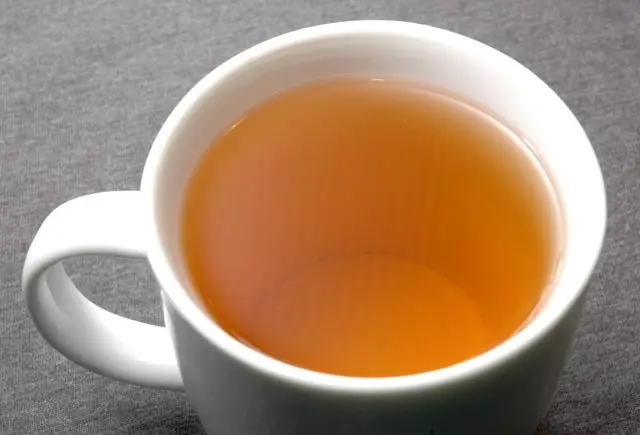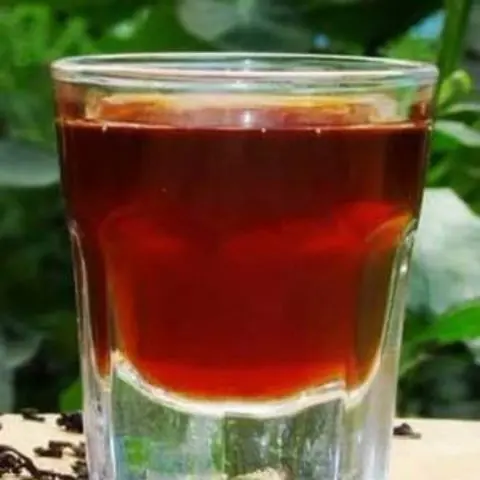Contents
Aleppo gravel (Geum aleppicum) is a herbaceous perennial that has unique healing properties. This is due to the chemical composition of its aerial part and the rhizome of the plant. Before using Aleppo gravilate for treatment, it is necessary to become more familiar with this culture, its areas of application and existing contraindications.

In folk medicine, the stems, roots and flowers of the Aleppo gravilate are used.
Description
This perennial is a plant with erect herbaceous stems, the height of which reaches 40-60 cm. The shoots are mostly hard-fibered with a slight edging on the surface.
The leaves of the Aleppo gravilate are pinnate, soft-fibered, tripartite. They are mainly concentrated in the lower part of the plant, where they are opposite and have long, stiff petioles. The size of the plates reaches 7 cm. The leaves are arranged alternately on the stems.
Perennial flowers are solitary, simple, consisting of 5 rounded petals of a bright yellow hue. In the center is a green center, on which numerous stamens are clearly visible. The fruits of Aleppo gravel are complex achenes with long, stiff hairs-hooks at the top. The root of the perennial is fleshy, short, located in the upper soil layer.

The diameter of the flowers does not exceed 1,5-2,0 cm
Where and how to grow
Perennial grows everywhere on forest edges, grassy slopes, in thickets of shrubs, along roads, and also not far from human habitation. Gravilat Allepsky is widely distributed throughout the world. In nature, it can be found in Europe, North America, East and Central Asia. In Our Country, Aleppo gravel grows in the Far East and Siberia.
The chemical composition and value of the plant
The root and aerial parts of the plant have healing properties. But they differ in chemical composition. The roots contain tannins, the mass fraction of which is 40%. Also in the underground part there is an essential oil with a high concentration of eugenol, starch, bitter substances, resins and hein glycoside.
In the shoots, leaves and flowers of the plant there are such valuable components:
- vitamin C (about 0,01%);
- carotene (more than 0,05%);
- tannins (4%);
- flavonoids (2%).
Medicinal properties
Perennial has a whole range of beneficial properties for human health. It is used externally and internally. Therefore, the culture is widely used in folk medicine for the treatment of many diseases.
Gravilat Aleppo has the following properties:
- hemostatic;
- sedative;
- anti-inflammatory;
- expectorant;
- choleretic;
- painkillers;
- wound healing;
- astringent;
- laxative;
- restorative.
Folk remedies based on Aleppo gravilate are used for such problems:
- diseases of the digestive system;
- bleeding of a different nature;
- epilepsy;
- headache;
- neuroses;
- dysentery;
- stomatitis;
- bleeding gums;
- allergic rash;
- toothache;
- eczema;
- neurodermatitis;
- convulsions;
- increased heart rate;
- insomnia;
- fever;
- rheumatism;
- scrofula;
- gynecological diseases.
In addition, the plant helps to strengthen the human immune system.
Application
The plant is widely used for the preparation of folk remedies and as a seasoning in cooking. But in traditional medicine, Aleppo gravilate is not used, since its properties have not yet been fully studied. However, this does not detract from its useful qualities.
In folk medicine
On the basis of this perennial, tincture, infusion, as well as powder from dried raw materials are prepared. These products are suitable for external and internal use.
Effective recipes:
- Infusion. Pour 1 tbsp. boiling water 20 g of crushed roots and shoots. Insist in a thermos for about 2 hours, cool, peel. Take orally 100 ml twice a day before meals for diseases of the digestive tract. And also the infusion should be used for rinsing with inflammation of the oral cavity.

- Tincture. Grind 15 g of dried roots, pour into a glass dark container. Pour raw materials with 100 g of vodka, close the lid. Infuse for 1 month in the dark, shake the bottle occasionally. Clear when the timeout expires. Take orally 10-15 drops with water before meals for 2 weeks as a tonic and sedative.

- Powder. Grind the dried roots and stems of the plant to a homogeneous consistency. Take 1 g twice a day before meals.

In cooking
The young tops of the shoots of Aleppo gravel and roots are used for food. Based on them, various dishes are prepared that improve the functioning of internal organs and systems.
Recipes:
- Soup. Boil meat broth. Add carrots, onions, parsley and a little sour cream to it. A pinch of crushed Aleppo gravilate roots and sorrel should be poured 5 minutes before readiness. This will give it a spice. You can also use spices if you like.
- Salad. For cooking, it is necessary to prepare the leaves of Aleppo gravel and wild onions. Wash the ingredients and pat dry. Then chop and add the boiled egg. Brush the salad with vegetable oil and season with salt.
In other areas
In other areas, except for cooking and traditional medicine, this plant is not used. The harvesting of raw materials of the aerial part should be carried out during the formation of buds or during the flowering period. Dig up the roots of the plant in the fall, when they contain a large amount of nutrients.
Противопоказания
This plant has no special contraindications for use. But you should refrain from using it in such cases:
- with individual intolerance to the component;
- during pregnancy;
- during lactation;
- with blood clotting disorders.
You should also stop taking folk remedies based on Aleppo gravilate with the appearance of nausea, dizziness and general malaise.
Conclusion
Gravilat Aleppo is a medicinal plant that helps to get rid of many health problems when used correctly. However, its reception should be started with small doses, only in the absence of side effects, you can gradually increase the amount. It should be understood that folk remedies from Aleppo gravel cannot replace the main treatment, but only act as an addition.












